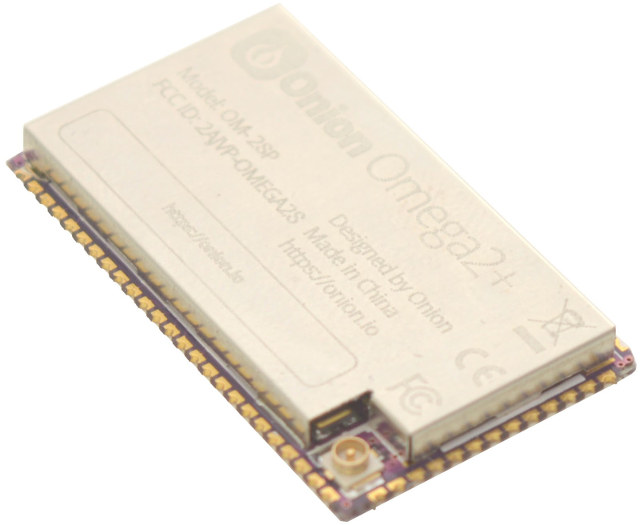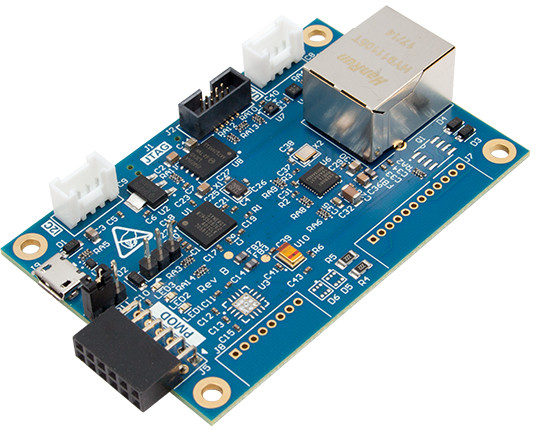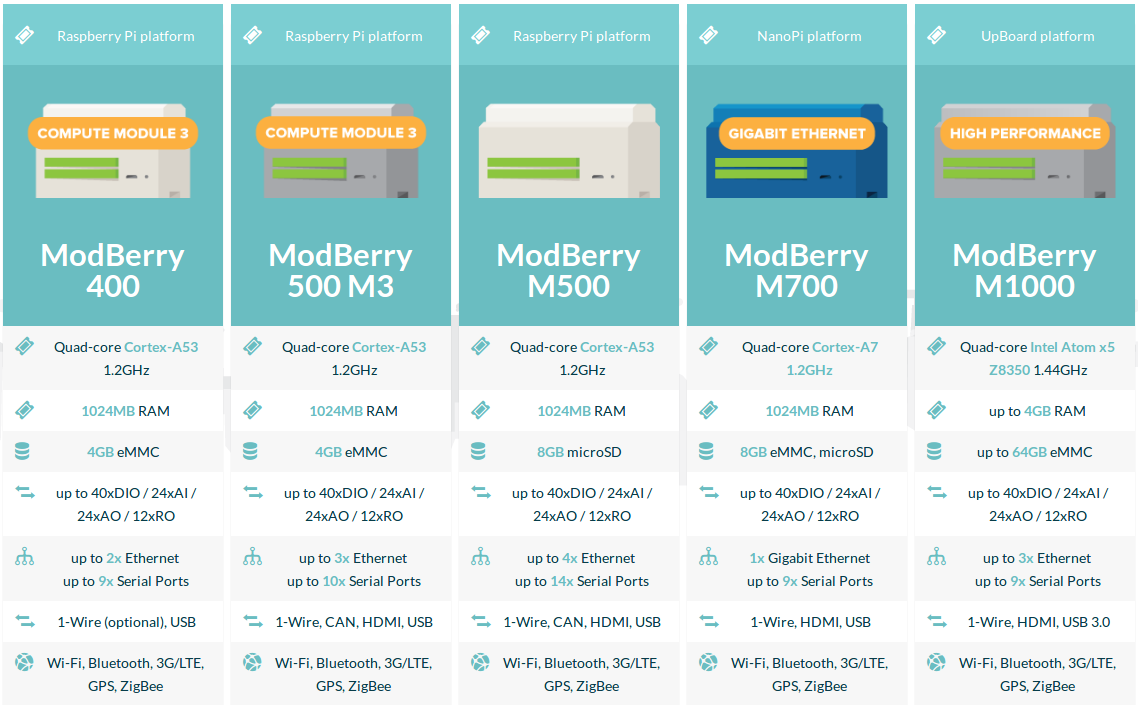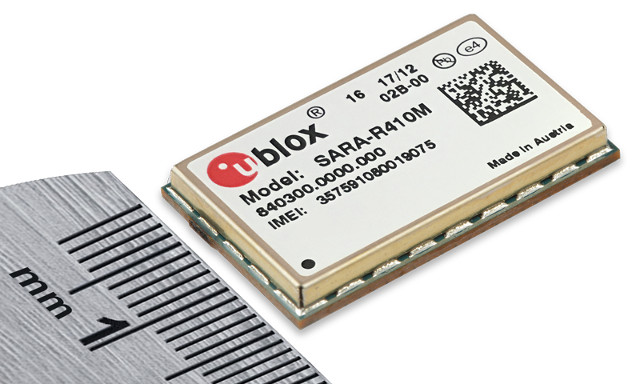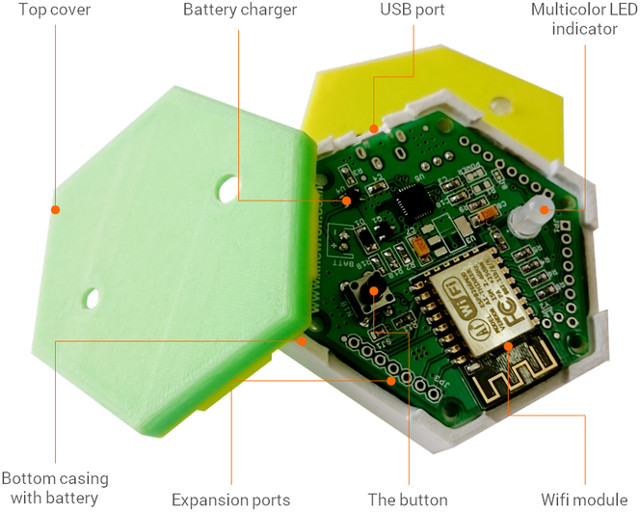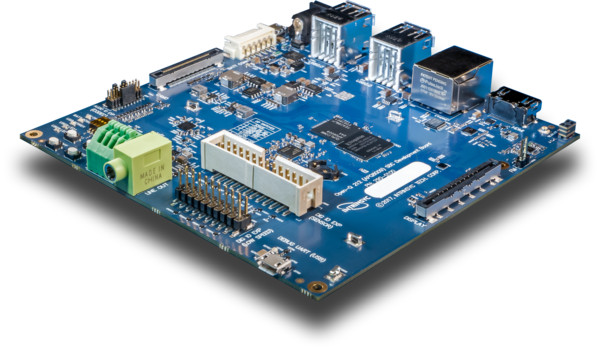Onion Omega2 and Omega2+ are tiny WiFi IoT development boards powered by Mediatek MT7688 MIPS processor running LEDE – OpenWrt fork – that sold for just $5 and up in Kickstarter, but are now selling for $7.50 and $9 respectively. The board also support various add-on boards, and a great for evaluation and various projects. But they may not be ideal for people who want to integrate the technology into their products, and that’s why the company have just launched Omega2S and Omega2S+ with about the same specifications, but in a package more suitable to be integrated into products for mass production. Onion Omega2S/2S+ specifications: WiSoC – Mediatek MT7688 MIPS processor @ 580 MHz System Memory / Storage Omega2S – 64MB DDR2 / 16MB flash Omega2S+ – 128MB DDR2 / 32 MB flash Connectivity – 802.11 b/g/n WiFi with u.FL antenna connector Baseboard Interface – Half holes (aka castellated holes) […]
Renesas S5D9 IoT Fast Prototyping Board Combines Cortex M4F MCU, Sensors, and Ethernet
Renesas S5D9 IoT Fast Prototyping board is a board designed – as its name implies – for the Internet of Things, with the company’s Synergy S5D9 ARM Cortex-M4F micro-controller, various sensors, various I/Os including protected digital inputs and outputs, and Ethernet for network connectivity instead of a Bluetooth or/and WiFi module. Renesas S5D9 board specifications: MCU – Renesas Synergy S5D9 ARM Cortex M4F MCU @120MHz with 2MB flash and 640KB SDRAM Storage – 256Mbits (32MB) QSPI NOR flash Connectivity – 1x 10/100Mbps Ethernet (RJ45) USB – 1x micro USB Full Speed port Sensors Bosch BMC150 6-Axis sensor (digital compass) AMS ENS210 environmental sensor for temperature and humidity data TE Connectivity MS5637-02BA03 barometric pressure sensor Knowles SPU0414HR5H-SB amplified SiSonic microphone Expansion 1x PMOD connector (SPI) 2x Grove Connectors (UART, I2C, GPIO) 2x Protected Digital Input (5.1V to 24V) + 2x Buffered Digital Output (up to 1A) via Molex 12 position header […]
ModBerry Industrial Automation Controllers Leverage Raspberry Pi, FriendlyELEC, and AAEON Boards and Modules
TECHBASE’s ModBerry Linux based industrial controllers have been around since 2014 with their first model being ModBerry 500 powered by a Raspberry Pi compute module. Over the years, the company has kept adding new ModBerry controllers with now an interesting choice of Raspberry Pi 3 board or compute module, FriendlyELEC’s NanoPi M1 Plus board, or Intel Atom x5 based AAEON’s UP board. All programmable automation controllers (PAC) runs Linux 4.0 or greater, with Debian or Ubuntu Core rootfs including ready tools and pre-compiled packs including C/C++, JAVA, SQL, PHP, SSH, and VPN support. The firmware is upgradeable over the air, and the controllers can run the company’s iMod control software and interface with iModCloud cloud computing service for telemetry, remote control and data sharing. Typical uses include C-L-V functions with conversion to collect and transmit data over communication interfaces, logging via iModCloud or a SCADA, and visualization via a web […]
Bluetooth Low Energy Now Supports Mesh Networking for the Internet of Things
The Bluetooth Special Interest Group (SIG) has announced support for mesh networking for BLE, which enables many-to-many (m:m) device communications, and is optimized for large scale device networks for building automation, sensor networks, asset tracking solutions, and other IoT solutions where up to thousands of devices need to reliably and securely communicate with one another. The standard actually specifies 32,767 unicast addresses per mesh network, but that number of nodes is not achievable right now. Mesh networking works with Bluetooth Low Energy and is compatible with version 4.0 and higher of the specifications. It requires SDK support for the GAP Broadcaster and Observer roles to both advertise and scan for advertising packets, and the FAQ claims Mesh Networking does not require extra power, and the devices only need to wake up at least once every four days or when they have data to transmit. Mobile apps connecting to mesh networking products […]
Office, Factory, Business Model, and Ambitious Plans of Shenzhen Xunlong Software, Orange Pi Maker
Parts of the article have been updated after Steven Zhao update at the end. Since Steven Zhao is the only one contact person at Shenzhen Xunlong Software, the maker of Orange Pi boards, and the company appears to be focusing on hardware development more than on software and documentation, so at one point in time, people were speculating that it could be one person operation 🙂 Last year, Steven told us there were over 10 persons working in the office. But hey, photos, or it’s fake! We now have a definite proof as Renaud Coustellier visited Steven Zhao in his Shenzhen Offices, and published a report on Minimachines (in French). I’ll provide a summary below, but visit Minimachines website, if you want the full story and more pictures. First, Shenzhen Xunlong rented a floor, or part of it, in one of the many Shenzhen office buildings, and engineers are working […]
U-blox SARA-R410M-02B Module Supports LTE Cat M1 and Cat NB1 in a Single Package
We previously covered U-blox SARA-R4 LTE Cat M1 and SARA M2 NB-IoT (Cat NB1) modules, but in case you need support for LTE Cat M1 and Cat NB1, instead of just one or the other, in your product, U-blox launched a new SARA-R4 model with SARA-R410M-02B module supporting both standards. U-blox SARA-R410M-02B module specifications: LPWAN connectivity LTE Cat M1 Half-duplex: 375 kb/s DL and UL LTE Cat NB1 Half-duplex: 27.2 kb/s DL, 62.5 UL Shared bands – 1, 2, 3, 4, 5, 8, 12, 13, 17, 18, 19, 20, 25, 26, 28; Cat M1-only band – 39 Coverage enhancement Mode A and Mode B (in upcoming firmware), 3GPP Rel 13 e-DRX (Extended Discontinuous Reception) supported in upcoming firmware SMS support – MT/MO PDU / Text mode; SMS over SG/NAS Voice – VoLTE (Cat M1) using AMR-WB codec (U)SIM supporting 1.8 and 3V GNSS/GPS support with CellLocate and Hybrid positioning coming […]
1btn is a Battery Powered Open Source ESP8266 WiFi Button
If you have some WiFi power switch like Sonoff TH16 at home, you’d normally control them using a mobile app or a web interface. This is all good, but getting your phone, unlocking it, and launching the app to turn on or off an appliance is not the most efficient way to operate, and in some cases, some people in the household may not know how to use a smartphone. Physical WiFi buttons are the solution, but there aren’t so many for sale. We’ve seen previously it was possible to hack an Amazon Dash, but it’s not really that flexible, and 1btn could potentially be a better option, as it’s open source and based on Espressif ESP8266 WiSoC. 1btn specifications: WiFi Module – ESP-12F based on Espressif ESP8266 MCU – Microchip Atmel ATmegaxx8 AVR MCU Connectivity – 802.11 b/g/b WiFi up to ~50 meter range USB – 1x USB port […]
Qualcomm Snapdragon 212 Boards – Intrinsyc Open-Q 212 and Kaynes Technology SKATE-212
Qualcomm Snapdragon 212 (APQ8009) quad core Cortex A7 processor is used in entry-level smartphones, but it’s also one of the processors which the company expects to use in their Smart Speaker Platform leveraging Google Assistant, Amazon Alexa, and other A.I. voice services. Two company has designed single board computers that can be used for this purpose: Intrisync Open-Q 212 and Kaynes Technology SKATE-212. Intrisync Open-Q 212 SBC Development Board Contrary to some other Open-Q boards, but not all, Open-Q 212 is not comprised of a baseboard and a system-on-module, as everything is soldered on a single PCB. Open-Q 212 specifications: SoC – Qualcomm Snapdragon 212 (APQ8009) quad core ARM Cortex A7 processor @ 1.267GHz with Adreno 304 GPU, QDSP6 DSP System Memory – 1GB LPDDR3 Storage – 8GB eMMC (non-POP) flash and micro SD card socket Connectivity – Ethernet, pre-scanned Wi-Fi 802.11n 2.4Ghz (WCN3610) with chip and U.FL antennas, Bluetooth 4.1 […]


